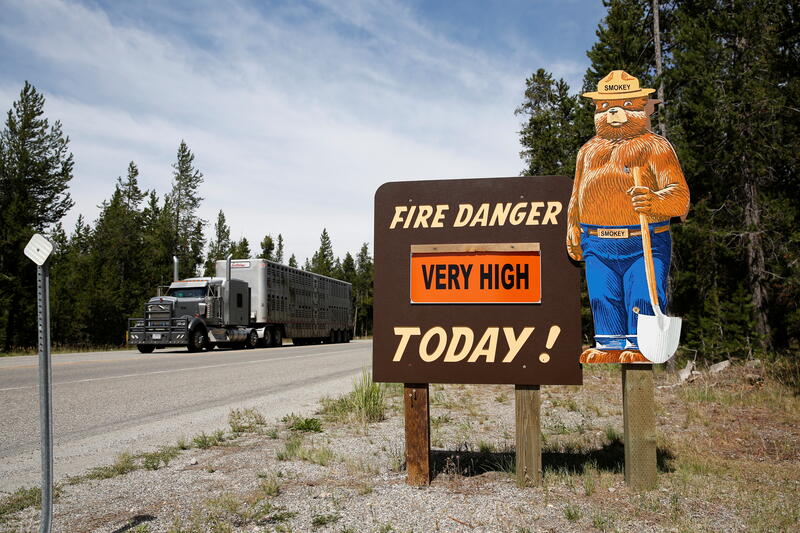To cover the aftermath of extreme disasters, journalists must start covering what we cannot rebuild

A sign warns of high fire risk outside Yellowstone National Park in August, 2021. Credit: Reuters/Brittany Hosea-Small.
I got my start in journalism working for the weekly Hungry Horse News in Columbia Falls, Montana.
Its founding editor, Mel Ruder, won a Pulitzer Prize for his coverage of a 1964 flood. As the waters rose almost to his log walled printing press, Ruder shifted to daily publication, rolling out 12,550 copies a day, four times his normal weekly print run. He drove his car on railroad tracks to reach places where the roads were under water. His carriers delivered copies by rowboat.
By the time I joined the “Horse” in 1987, the Flood of 1964 was sort of a campfire tale—a recollection of newsroom adventure none of us current reporters seemed likely to experience.
And yet, accelerating climate change has meant that what once seemed unlikely has grown to be almost routine.
Once the floodwaters recede or the flames burn out, reporters rush in to relay the community’s tales of survival and loss. And we're usually just a step ahead or behind the local politicians promising recovery and rebuilding.
While they're peddling hope, however, we need to look harder at what the future will bring and prepare our audiences for what’s to come. Many of the changes we are seeing in our natural environment as a result of climate change are irreversible, and simply rebuilding an exact replica of what we had before is often a waste of time and resources, at best.
The reality is that across North America, floods and wildfires have become so costly that major insurance providers are abandoning the market. No amount of fire-resistant home construction or floodplain zoning will make those homesites affordable or sustainable again.
Instead, our reporting should help audiences understand how the climate forces underpinning those disasters must be recognised and acknowledged to prevent us simply making the same mistakes once again.
That means getting familiar with sources who advise on long-term planning, such as insurance industry analysts, climate scientists, agricultural development advisors, and demographers who track residential moving trends. Watching where people make (or abandon) big investments, and where people move to preceived safety or away from routine misfortune, helps put local disasters in a more global context.
At the Missoulian, where I am the managing editor, we saw this cycle unfold in real time last year. The 2022 Yellowstone Flood inundated towns and tore out highways. It overtook a floodplain with a once-in-500-years chance of flooding. (The U.S. government’s Federal Emergency Management Agency is now considering reclassifying that floodplain’s risks to be more like once in every 100 years.)
The flood obliterated at least five sections of the North Entrance Road into Yellowstone National Park, the famous U.S. national park that stretches across Wyoming, Montana and Idaho. It bit off hunks of pavement like a great white shark feeding on a whale carcass. Downstream, in the park border town of Gardiner, Montana, tourists posted videos of two-story houses tumbling into the Yellowstone River and floating off toward Paradise Valley.
At the scene of such incidents, the first thing many victims want to talk about is how soon they can return to normal, and how long it will take to rebuild. Four days after the floodwaters receded around Gardiner, Montana Gov. Greg Gianforte stood in the middle of town and announced: “We’re open. You’ve got to come. There is so much to do in Montana and the vitality of our communities depend on it, and your families need what we have in Montana.”
And yet, the North Entrance Road destroyed in the floods will likely never be rebuilt.
Instead of celebrating Yellowstone’s 150th anniversary last year, the National Park Service scrambled to transform an 1880s-vintage single-lane “Stage Coach Road” into a modern, two-lane paved connection between Gardiner and the park’s headquarters at Mammoth. Its new incarnation runs barely four miles and cost an estimated $5 million a mile to build. It overlooks the old road, letting every tourist see how the river reclaimed its floodplain and ruined the roadbed.
That picture is repeating itself around the globe. Internationally, natural disasters inflicted $275 billion in global economic losses in 2022, according to the global insurer Swiss Re.
Rebuilding is also becoming more difficult as the disasters themselves become more complex. FEMA has now created a “post-wildfire exception” to its usual 30-day waiting period for flood disaster insurance, due to the growing number of multi-faceted disasters. A home spared from a forest fire could still get wrecked when a rainstorm erodes the burned-off hillside and sends a mudslide through the kitchen.
Because Yellowstone National Park encloses one of the world’s most active geothermal areas, its engineers have grown accustomed to natural forces rearranging the landscape. Tourists wander past famous geyser spouts that have gone dormant, only to find their path detoured because a new thermal feature has erupted under the boardwalk.
The chance to experience a landscape literally churning with unpredictability has always been one of Yellowstone Park’s attractions. The increasing tempo of natural disasters worldwide means those are no longer isolated incidents affecting remote places. At the old Hungry Horse News, Mel Ruder had to find new ways to get the news out about disaster recovery. Now we must seek new ways and sources to explain what’s not coming back.




